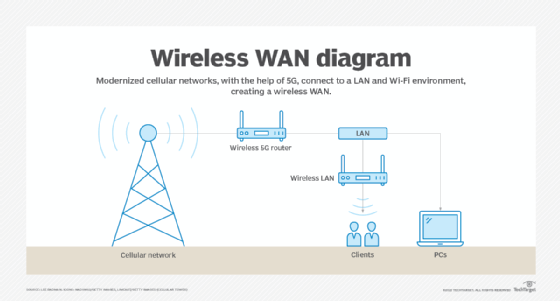An overview of wireless WAN
Hybrid work, modernized cellular networks, and the convergence of 5G and software-defined networking are driving factors in the maturation of wireless WAN.
Wireless technologies pervade the nooks and crannies of daily life, from smart home links to satellite-based ISP connections. For many of us, Wi-Fi has become our main network access method, backed up by cellular broadband connections. It's a wireless world in countless ways, and one of the more interesting applications is the wireless wide area network, or WWAN.
In general, wireless is about reducing costly wired network connections, getting connectivity to difficult locations and enabling endpoint devices to take advantage of new technologies. The WWAN paradigm conforms to that philosophy. When designed and used correctly, WWAN environments can offer impressive network reliability. But what exactly is a WWAN?
What is wireless WAN?
A WWAN is a system that connects multiple campuses, far-flung buildings or large areas in which client devices in a single organization need wireless connectivity.
A WWAN tends to incorporate different access or distribution technology compared to the typical wireless LAN (WLAN). A WLAN is usually confined to a building or campus and based on 802.11 Wi-Fi. A WWAN, on the other hand, can use cellular wireless, mesh and bridge technologies and possibly even satellite links for specific applications. Some WANs are global in scale.
Terms like local and wide area can be subjective and vary greatly depending on specific scenarios, but the basic notions of each at least help in understanding one versus the other.

What is wireless WAN used for?
The wide area wireless network covers a few different operational goals, including the following:
- providing a foundational wireless broadband network anywhere in the cellular network providers' coverage zones for client access;
- offering backhaul of small LAN topologies to the internet, either as primary backhaul or as a backup strategy for a wired ISP connection;
- connecting widely dispersed sensors, vehicles or other IoT devices to a common network over a large geographical area, supporting utilitarian applications -- examples include rail and interstate sensors, cameras and signaling; and
- providing connectivity for a range of situations not solvable by WLAN and other wireless types.
Wireless WAN technologies
Wireless WANs can be constructed of one or more technologies as needed to achieve the operational goals of each specific use case. The technologies in play include the following:
- Carrier 4G LTE/5G public networks. In a large geographic area, these technologies often provide an easily used secure connection for client devices that join a specific network or application framework via proprietary means.
- Private 4G LTE/5G networks. Offering the same technical advantages of the carrier networks, private cellular gives an organization strict control over what client devices are used, including LTE and 5G routers and adapters. Private cellular might also add application-specific traffic management features in the network core, depending on the applications in use.
- Proprietary wireless bridging and mesh technologies. These may be in licensed or unlicensed bands and can be used strictly for network distribution or client device access, depending on the models in use.
- Satellite links. The planet is certainly getting smaller when it comes to technology's reach, and recent developments in satellite access technologies provide new options for extending wireless WANs virtually anywhere.
What are the advantages of WWAN?
Building and expanding a WAN without being constrained by the physical limits of wiring is quite empowering. The following are some of the advantages of WWAN:
- When required, organizations can take advantage of disparate wireless technologies to extend the physical reach of the network.
- In some cases, wireless implementation is much faster than wired alternatives.
- Pop-up and short-duration network segments become affordable options during certain events and projects.
- Limits are often defined only by budget and creativity.
What are the disadvantages of WWAN?
As with any technology, some drawbacks exist. With WWAN, the potential disadvantages include the following:
- It's still wireless, and that means being subject to natural or human-made interference, even when licensed frequencies are used.
- Using the carriers' cellular networks in your WWAN means giving up control and management of the network.
- In pay-as-you-go carrier networks, organizations could face high costs if the wrong subscription terms are used.
- Compared to high-end wired connectivity, network performance tends to be far more variable -- even over the best wireless technologies.
- Some product markets are still evolving and pricing hasn't reached commodity levels, like with Citizens Broadband Radio Service.
- Direct client support for certain wireless technologies can be messy.
Is WWAN viable?
The COVID-19 pandemic created legions of hybrid and remote employees who rely on the WWAN model to connect them to the corporate network. As carriers continue to modernize their networks with the advent of 5G, reduced latencies and increases in speed and capacity enable the WWAN model to gain market share as various technologies -- including software-defined networking (SDN) -- are layered over it.
When implemented properly, WWAN is viable in several roles and continues to garner interest as enterprise networks and their use cases evolve.
WWAN vendor Cradlepoint is arguably the standard-bearer for providing components like 5G routers that use WWAN for enterprise use. But the field is growing as traditional networking vendors embrace the opportunities that come with WWAN.
Whether a branch location is being turned up or a short-term event needs networking, making use of WWAN can be the difference between success and no network at all, especially in difficult-to-wire locations. Carriers are getting the message that flat-rate pricing and data pooling for multiple subscriptions help customers consider WWAN as an affordable option versus "the meter is always running" paradigm of yesterday.
WWAN is a space to watch, especially considering today's evolving work models and the fast convergence of several technologies, including 5G, SDN and private cellular.
Wireless WAN vs. wireless LAN vs. Wi-Fi: What are the differences?
When comparing WWAN, WLAN and Wi-Fi, the distinctions can be minor but they're worth calling out -- at least to make the point there's more to wireless than just Wi-Fi.
As a whole, wireless networking can be split into several smaller buckets. Above, we already mentioned the differences between WWAN and WLAN, so where does Wi-Fi fit? Generally, we don't find or use Wi-Fi in wireless WAN, so that part is easy. On the WLAN front, Wi-Fi is simply one variant -- and currently the dominant one -- in wireless LAN.








